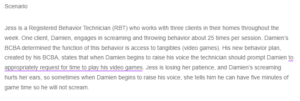Implementing Effective Behavior Management Strategies for Clients with Challenging Behaviors- A Case Study Approach
Target Behavior
The target behavior for the RBT, Jess, is to prompt Damien to appropriately request for time to play his video games.
The Process of Identifying the Probable Function of Jess’s Target Behavior
The first step is to conduct a functional behavior assessment. This includes assessing Damien’s behavior before he engages in screaming and throwing. Shepherd and Linn (2015) refer to this prior behavior as antecedent or what takes place before Damien engages in the behavior. The assessment also involves evaluating the consequences of Damien’s behavior or what takes place after he engages in the behavior. This assessment can be done by observing Damien or involving his caregivers or teachers in an interview.
Antecedents and Consequences and the Probable Function of the Target Behavior
The antecedent in this scenario is Damien raising his voice, and the consequence of that is Jess allowing him to have five minutes of game time because the scream hurts Jess’s ears. The probable function of the target behavior is to avoid the needed situation of appropriately asking for game time and accessing the tangibles, including video games.
A Potential Function-Based BIP for Jess and How I Would Provide Her With Feedback Regarding This Behavior
A potential function-based behavior intervention plan (BIP) for Jess is to minimize Damien’s screaming behavior and educate him on properly asking for game time. She can focus on replacing the behavior. For instance, Jess can teach Damien how to use a communication approach such as sign language, a picture, or a verbal request to ask for game time (Killu, 2008). She can also modify the antecedent by offering video schedules to assist Damien in understanding when he can have time for video games (Miltenberger, 2015). She can modify the consequences as well by not immediately granting him video game access but by reinforcing it with appropriate communication and then granting the request (Miltenberger, 2015). This can be backed up with praise (Cooper et al., 2020). In providing Jess with feedback, I would first praise her for replacing the behavior with a more beneficial remedy and being patient with Damien. I would encourage her to work with the BCBA for coaching and support, especially during challenging times while working with Damien. I would also advise her to have an open communication approach and insist on the appropriate behavior until Damien gets used to it.
References
Cooper, J. O., Heron, T. E., & Heward, W. L. (2020). Applied behavior analysis. Pearson UK.
Killu, K. (2008). Developing effective behavior intervention plans and Suggestions for school personnel. Intervention in School & Clinic, 43(3), 140-149.
Miltenberger, R. G. (2015). Behavior modification: Principles and procedures (6th Edition). Cengage Limited.
Shepherd, T. L., & Linn, D. (2015). Behavior and classroom management in the multicultural classroom: Proactive, active, and reactive strategies. SAGE Publications
ORDER A PLAGIARISM-FREE PAPER HERE
We’ll write everything from scratch
Question 
Scenario
Jess is a Registered Behavior Technician (RBT) who works with three clients in their homes throughout the week. One client, Damien, engages in screaming and throwing behavior about 25 times per session. Damien’s BCBA determined the function of this behavior is access to tangibles (video games). His new behavior plan, created by his BCBA, states that when Damien begins to raise his voice the technician should prompt Damien to appropriately request for time to play his video games. Jess is losing her patience, and Damien’s screaming hurts her ears, so sometimes when Damien begins to raise his voice, she tells him he can have five minutes of game time so he will not scream.

Implementing Effective Behavior Management Strategies for Clients with Challenging Behaviors- A Case Study Approach
Discussion
Please complete your assigned readings and respond to the following:
What is the target behavior for the RBT, Jess?
Explain the process you would undertake to identify the probable function of Jess’s target behavior.
Discuss the antecedents and consequences in this scenario and hypothesize the probable function of the target behavior.
Describe a potential function-based BIP for Jess, and discuss how you will provide her with feedback regarding this behavior.

